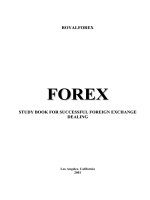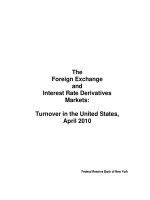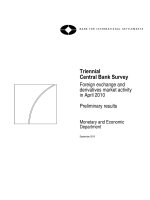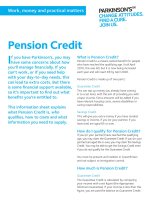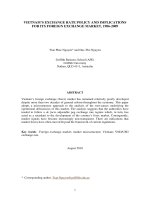Forex derivatives trader school technical and practical techniques for trading foreign exchange derivatives
Bạn đang xem bản rút gọn của tài liệu. Xem và tải ngay bản đầy đủ của tài liệu tại đây (16.08 MB, 620 trang )
www.ebook3000.com
www.ebook3000.com
FX DERIVATIVES
TRADER SCHOOL
www.ebook3000.com
The Wiley Trading series features books by traders who have survived the
market’s ever changing temperament and have prospered—some by reinventing
systems, others by getting back to basics. Whether a novice trader, professional,
or somewhere in-between, these books will provide the advice and strategies
needed to prosper today and well into the future. For more on this series, visit
our Web site at www.WileyTrading.com.
Founded in 1807, John Wiley & Sons is the oldest independent publishing
company in the United States. With offices in North America, Europe, Australia,
and Asia, Wiley is globally committed to developing and marketing print and
electronic products and services for our customers’ professional and personal
knowledge and understanding.
www.ebook3000.com
FX DERIVATIVES
TRADER SCHOOL
Giles Jewitt
www.ebook3000.com
Copyright c 2015 by Giles Jewitt. All rights reserved.
Published by John Wiley & Sons, Inc., Hoboken, New Jersey.
Published simultaneously in Canada.
No part of this publication may be reproduced, stored in a retrieval system, or transmitted in any form or by
any means, electronic, mechanical, photocopying, recording, scanning, or otherwise, except as permitted
under Section 107 or 108 of the 1976 United States Copyright Act, without either the prior written permission
of the Publisher, or authorization through payment of the appropriate per-copy fee to the Copyright Clearance
Center, Inc., 222 Rosewood Drive, Danvers, MA 01923, (978) 750-8400, fax (978) 646-8600, or on the Web
at www.copyright.com. Requests to the Publisher for permission should be addressed to the Permissions
Department, John Wiley & Sons, Inc., 111 River Street, Hoboken, NJ 07030, (201) 748-6011, fax (201)
748-6008, or online at />Limit of Liability/Disclaimer of Warranty: While the publisher and author have used their best efforts in
preparing this book, they make no representations or warranties with respect to the accuracy or completeness
of the contents of this book and specifically disclaim any implied warranties of merchantability or fitness for a
particular purpose. No warranty may be created or extended by sales representatives or written sales materials.
The advice and strategies contained herein may not be suitable for your situation. You should consult with a
professional where appropriate. Neither the publisher nor author shall be liable for any loss of profit or any
other commercial damages, including but not limited to special, incidental, consequential, or other damages.
For general information on our other products and services or for technical support, please contact our
Customer Care Department within the United States at (800) 762-2974, outside the United States at (317)
572-3993 or fax (317) 572-4002.
Wiley publishes in a variety of print and electronic formats and by print-on-demand. Some material included
with standard print versions of this book may not be included in e-books or in print-on-demand. If this book
refers to media such as a CD or DVD that is not included in the version you purchased, you may download this
material at . For more information about Wiley products, visit
www.wiley.com.
Library of Congress Cataloging-in-Publication Data:
ISBN 9781118967454 (Paperback)
ISBN 9781119096610 (ePDF)
ISBN 9781119096474 (ePub)
Cover image: Business World c iStock.com/ktsimage; abstract background c iStock.com/PiexelEmbargo
Cover design: Wiley
Printed in the United States of America
10 9 8 7 6 5 4 3 2 1
www.ebook3000.com
For my wife and daughters: Laura, Rosie, and Emily.
www.ebook3000.com
www.ebook3000.com
CONTENTS
Preface
Acknowledgments
xi
xiii
PART I
The Basics
1
CHAPTER 1
Introduction to Foreign Exchange
3
CHAPTER 2
Introduction to FX Derivatives
11
CHAPTER 3
Introduction to Trading
19
Practical A
Building a Trading Simulator in Excel
27
CHAPTER 4
FX Derivatives Market Structure
39
CHAPTER 5
The Black-Scholes Framework
57
Practical B
Building a Numerical Integration Option Pricer in Excel
69
CHAPTER 6
Vanilla FX Derivatives Greeks
77
Practical C
Building a Black-Scholes Option Pricer in Excel
91
CHAPTER 7
Vanilla FX Derivatives Pricing
103
CHAPTER 8
Vanilla FX Derivatives Structures
121
www.ebook3000.com
vii
CONTENTS
viii
CHAPTER 9
Vanilla FX Derivatives Risk Management
137
CHAPTER 10
Vanilla FX Derivatives Miscellaneous Topics
159
Practical D
Generating Tenor Dates in Excel
165
PART II
The Volatility Surface
169
CHAPTER 11
ATM Curve Construction
171
Practical E
Constructing an ATM Curve in Excel
193
CHAPTER 12
Volatility Smile Market Instruments and
Exposures
205
Practical F
Constructing a Volatility Smile in Excel
233
CHAPTER 13
Probability Density Functions
241
Practical G
Generating a Probability Density Function from Option
Prices in Excel
253
PART III
Vanilla FX Derivatives Trading
261
CHAPTER 14
Vanilla FX Derivatives Trading Exposures
263
CHAPTER 15
Vanilla FX Derivatives Trading Topics
293
CHAPTER 16
ATM Volatility and Correlation
313
CHAPTER 17
FX Derivatives Market Analysis
323
PART IV
Exotic FX Derivatives
355
CHAPTER 18
Exotic FX Derivatives Pricing
357
CHAPTER 19
FX Derivatives Pricing Models
375
CHAPTER 20
Exotic FX Derivatives Product Classification
387
CHAPTER 21
European Digital Options
399
CHAPTER 22
European Barrier Options
413
CHAPTER 23
Touch Options
423
CHAPTER 24
American Barrier Options
439
CHAPTER 25
Exotic FX Derivatives Trading Topics
461
CHAPTER 26
Window Barrier and Discrete Barrier Options
473
Practical H
Building a Monte Carlo Option Pricer in Excel
485
CHAPTER 27
Vanilla Variations
497
CHAPTER 28
Accrual and Target Redemption Options
515
CHAPTER 29
Asian Options
527
CHAPTER 30
Multi-Asset Options
539
CHAPTER 31
Miscellaneous Options
555
573
About the Companion Website
575
Index
577
ix
CONTENTS
Further Reading
PREFACE
I
n 2004 I started on an FX derivatives trading desk as a graduate. I wrote down
everything I learned: how markets worked, how FX derivatives contracts were
risk-managed, how to quote prices, how Greek exposures evolve over time, how
different pricing models work, and so on. This book is a summary of that knowledge,
filtered through a decade of trading experience across the full range of FX derivatives
products.
In 2011 I started sending out monthly ‘‘Trader School’’ e-mails to traders on the
desk, covering a wide range of topics. The e-mails were particularly popular with
new joiners and support functions because they gave an accessible view of derivatives
trading that did not exist elsewhere. This book collects together and expands upon
those e-mails.
Part I covers the basics of FX derivatives trading. This is material I wish I’d
had access to when originally applying for jobs on derivatives trading desks. Part II
investigates the volatility surface and the instruments that are used to define it.
Part III covers vanilla FX derivatives trading and shows how the FX derivatives
market can be analyzed. Part IV covers exotic FX derivatives trading, starting
with the most basic products and slowly increasing the complexity up to advanced
volatility and multi-asset products. This material will mostly be useful to junior
traders or traders looking to build or refresh their knowledge in a particular area.
Fundamentally, the aim of the book is to explain derivatives trading from first
principles in order to develop intuition about derivative risk rather than attempting
to be state of the art. Within the text, experienced quant traders will find many
statements that are not entirely true, but are true the vast majority of the time.
Endlessly caveating each statement would make the text interminable.
xi
PREFACE
xii
Traders can only be successful if they have a good understanding of the framework
in which they operate. Importantly though, for derivatives traders this is not the
same as fully understanding derivative mathematics. Therefore the mathematics is
kept to an accessible ‘‘advanced high school’’ level throughout. Some mathematical
rigor is lost as a result of this, but for traders that is a price worth paying.
Also in the interests of clarity, some other important considerations are largely
ignored within the analysis, most notably, credit risk (i.e., the risk of a counterparty
defaulting on money owed) and interest rates (i.e., how interest rate markets work
in practice). Derivative product analysis is the primary concern here and this is
cleaner if those issues are ignored or simplified.
Regulations and technology are causing significant changes within the FX derivatives market structure. The most important changes are increasing electronic
execution, increasing electronic market data, more visibility on transactions occurring in the market, and less clear distinctions between banks and their clients. These
changes will have profound and lasting effects on the market. However, the ideas and
techniques explored within the book hold true no matter how the market structure
changes.
Finally, and most importantly, if you are a student or new joiner on a derivatives
trading desk: Do the practicals. I can guarantee that if you complete the practicals,
you will hit the ground running when you join a derivatives trading desk. Do them.
Do them all. Do them all in order. Do not download the spreadsheets from the
companion website unless you are completely stuck. When you’re trying to learn
something, taking the easy option is never the right thing to do. The practicals
require the ability to set up Excel VBA (Visual Basic for Applications) functions and
subroutines. If you aren’t familiar with this, there is plenty of material online that
covers this in detail.
The very best of luck with your studies and careers,
Giles Jewitt, London, 2015.
ACKNOWLEDGMENTS
T
hanks are due to
… those who taught me:
Fred Boillereau
Jeff Wang
Mike Killen
Rob Ross
Hossein Zaimi
… those who supported me in writing the book and helped make it happen:
Howard Savery
Caroline Prior
Vincent Craignou
Selene Chong
… all colleagues who helped me with content, especially:
Chris Potter
Charlie Chamberlain
Daniela Asikian
Allen Li
… Marouane Benchekroun and his Quants for the tools I used to produce most
of the charts in the book.
… those who looked after my girls and I while the book was completed:
Frances, Tony, Phil, Gerry, Tim, Jod and Mark.
… my family for their support, encouragement and assistance: Mum, Dad,
and Anna.
xiii
This publication reflects the views of the author only.
This publication is intended to be educational in nature and should be used for
information purposes only.
Any opinions expressed herein are given in good faith, but are subject to change
without notice.
Any strategies discussed are strictly for illustrative and educational purposes only
and are not to be construed as an endorsement, recommendation, or solicitation to
buy or sell any financial securities.
All rates and figures used are for illustrative purposes only and do not reflect
current market rates.
ACKNOWLEDGMENTS
xiv
FX DERIVATIVES
TRADER SCHOOL
PART I
THE BASICS
P
art I lays the foundations for understanding FX derivatives trading. Trading
within a financial market, market structure, and the Black-Scholes framework
are all covered from first principles. FX derivatives trading risk is then introduced
with an initial focus on vanilla options since they are by far the most commonly
traded contract.
CHAPTER 1
Introduction to
Foreign Exchange
T
he foreign exchange (FX) market is an international marketplace for trading
currencies. In FX transactions, one currency (sometimes shortened to CCY)
is exchanged for another. Currencies are denoted with a three-letter code and
currency pairs are written CCY1/CCY2 where the exchange rate for the
currency pair is the number of CCY2 it costs to buy one CCY1. Therefore, trading
EUR/USD FX involves exchanging amounts of EUR and USD. If the FX rate goes
higher, CCY1 is getting relatively stronger against CCY2 since it will cost more
CCY2 to buy one CCY1. If the FX rate goes lower, CCY1 is getting relatively
weaker against CCY2 because one CCY1 will buy fewer CCY2.
If a currency pair has both elements from the list in Exhibit 1.1, it is described as
a G10 currency pair.
The most commonly quoted FX rate is the spot rate, often just called spot. For
example, if the EUR/USD spot rate is 1.3105, EUR 1,000,000 would be exchanged
for USD 1,310,500. Within a spot transaction the two cash flows actually hit the
bank account (settle) on the spot date, which is usually two business days after the
transaction is agreed (called T+2 settlement). However, in some currency pairs,
for example, USD/CAD and USD/TRY (Turkish lira), the spot date is only one
day after the transaction date (called T+1 settlement).
Another set of commonly traded FX contracts are forwards, sometimes called
forward outrights. Within a forward transaction the cash flows settle on some
future date other than the spot date. When rates are quoted on forwards, the tenor
or maturity of the contract must also be specified. For example, if the EUR/USD
1yr (one-year) forward FX rate is 1.3245, by transacting this contract in EUR10m
3
EXHIBIT 1.1 G10 Currencies
INTRODUCTION TO FOREIGN EXCHANGE
4
CCY Code
Full Name
CCY Code
Full Name
AUD
CAD
CHF
EUR
GBP
Australian dollar
Canadian dollar
Swiss franc
Euro
Great British pound
JPY
NOK
NZD
SEK
USD
Japanese yen
Norwegian krone
New Zealand dollar
Swedish krona
United States dollar
(ten million euros) notional, each EUR will be exchanged for 1.3245 USD (i.e.,
EUR10m will be exchanged for USD13.245m in one year’s time). In a given
currency pair, the spot rate and forward rates are linked by the respective interest
rates in each currency. By a no-arbitrage argument, delivery to the forward maturity
must be equivalent to trading spot and putting the cash balances in each currency
into ‘‘risk-free’’ investments until the maturity of the forward. This is explained in
more detail in Chapter 5.
Differences between the spot rate and a forward rate are called swap points or
forward points. For example, if EUR/USD spot is 1.3105 and the EUR/USD
1yr forward is 1.3245, the EUR/USD 1yr swap points are 0.0140. In the market,
swap points are quoted as a number of pips. Pips are the smallest increment in
the FX rate usually quoted for a particular currency pair. In EUR/USD, where FX
rates are usually quoted to four decimal places, a pip is 0.0001. In USD/JPY, where
FX rates are usually only quoted to two decimal places, a pip is 0.01. In the above
example, an FX swaps trader would say that EUR/USD 1yr swap points are at 140
(‘‘one-forty’’).
Pips (sometimes called ‘‘points’’) are also used to describe the magnitude of FX
moves (e.g., ‘‘EUR/USD has jumped forty pips higher’’ if the EUR/USD spot
rate moves from 1.3105 to 1.3145). Another term used to describe spot moves is
figure, meaning one hundred pips (e.g., ‘‘USD/JPY has dropped a figure’’ if the
USD/JPY spot rate moves from 101.20 to 100.20).
FX swap contracts contain two FX deals in opposite directions (one a buy, the
other a sell). Most often one deal is a spot trade and the other deal is a forward
trade to a specific maturity. The two trades are called the legs of the transaction
and the notionals on the two legs of the FX swap are often equal in CCY1 terms
(e.g., buy EUR10m EUR/USD spot against sell EUR10m EUR/USD 1yr forward).
FX swaps are quoted in swap point terms (the difference in FX rate) between the
two legs. In general, swap points change far less frequency than spot rates in a given
currency pair.
A trader takes up a new FX position by buying USD10m USD/CAD spot at a rate
of 0.9780. This means buying USD10m and simultaneously selling CAD9.78m. This
position is described as ‘‘long ten dollar-cad,’’ meaning USD10m has been bought
and an equivalent amount of CAD has been sold. If USD10m USD/CAD had been
sold at 0.9780 instead, the position is described as ‘‘short ten dollar-cad.’’ Note that
the long/short refers to the CCY1 position. The concept of selling something you
don’t initially own is a strange one in the real world but it quickly becomes normal in
financial markets where trading positions can flip often between long (a net bought
position) and short (a net sold position).
USD/CAD spot jumps up to 0.9900 after it was bought at 0.9780: The trader
is a hero! Time to sell USD/CAD spot and lock in the profit. Selling USD10m
USD/CAD spot at 0.9900 results in selling USD10m against buying CAD9.9m.
The initial bought USD10m and new sold USD10m cancel out, leaving no net USD
position, but the initial sold CAD9.78m and new bought CAD9.9m leave CAD120k
profit. This is important: FX transactions and positions are usually quoted in CCY1
terms (e.g., USD10m USD/CAD) while the profit and loss (P&L) from the trade is
naturally generated in CCY2 terms (e.g., CAD120k).
A long position in a financial instrument makes money if the price of the instrument
rises and loses money if the price of the instrument falls. Mathematically, the intraday
P&L from a long spot position is:
P&LCCY2 = NotionalCCY1 .(ST − S0 )
EXHIBIT 1.2
P&L from long USD10m USD/CAD spot at 0.9780
5
INTRODUCTION TO FOREIGN EXCHANGE
where S0 is the initial spot rate and ST is the new spot rate.
Exhibit 1.2 shows the P&L from a long spot position. As expected, P&L expressed
in CCY2 terms is linear in spot.
A short position in a financial instrument makes money if the price of the instrument
falls and loses money if the price of the instrument rises. The intraday P&L from a short
spot position is also:
P&LCCY2 = NotionalCCY1 .(ST − S0 )
However, the notional will be negative to denote a short position.
Exhibit 1.3 shows the P&L from a short spot position. Again, P&L expressed in
CCY2 terms is linear in spot.
If the P&L from these spot deals is brought back into CCY1 terms, the conversion
between CCY2 and CCY1 takes place at the prevailing spot rate. Therefore, the
CCY1 P&L from a spot position is:
P&LCCY1 = NotionalCCY1 .
(ST − S0 )
ST
At lower spot levels, an amount of CCY2 will be worth relatively more CCY1
(spot lower means CCY2 stronger and CCY1 weaker). At higher spot levels, an
amount of CCY2 will be worth relatively fewer CCY1 (spot higher means CCY1
stronger and CCY2 weaker). This effect introduces curvature into the P&L profile
as shown in Exhibit 1.4.
INTRODUCTION TO FOREIGN EXCHANGE
6
EXHIBIT 1.3
P&L from short USD10m USD/CAD spot at 0.9780
EXHIBIT 1.4
P&L from long USD100m USD/JPY spot at 101.00
■ Practical Aspects of the FX Market
7
INTRODUCTION TO FOREIGN EXCHANGE
The international foreign exchange market is enormous, with trillions of dollars’
worth of deals transacted each day. The most important international center for FX
is London, followed by New York. In Asia, Tokyo, Hong Kong, and Singapore are
roughly equally important.
The USD is by far the most frequently traded currency with the majority of
FX trades featuring USD as either CCY1 or CCY2. EUR/USD is the most traded
currency pair, followed by USD/JPY and then GBP/USD.
FX traders draw a distinction between major currency pairs: the most
commonly traded currency pairs, usually against the USD, and cross currency
pairs. For example, EUR/USD and AUD/USD are majors while EUR/AUD is a
cross. FX rates in cross pairs are primarily determined by the trading activity in the
majors. The FX market is highly efficient so if EUR/USD spot is trading at 1.2000
and AUD/USD spot is trading at 0.8000, EUR/AUD spot will certainly be trading
at 1.5000 (1.2/0.8).
Exhibit 1.5 is a mocked-up screen-grab of a market-data tool showing live spot
rates in major G10 currency pairs. In practice these rates change (tick) many times
a second.

